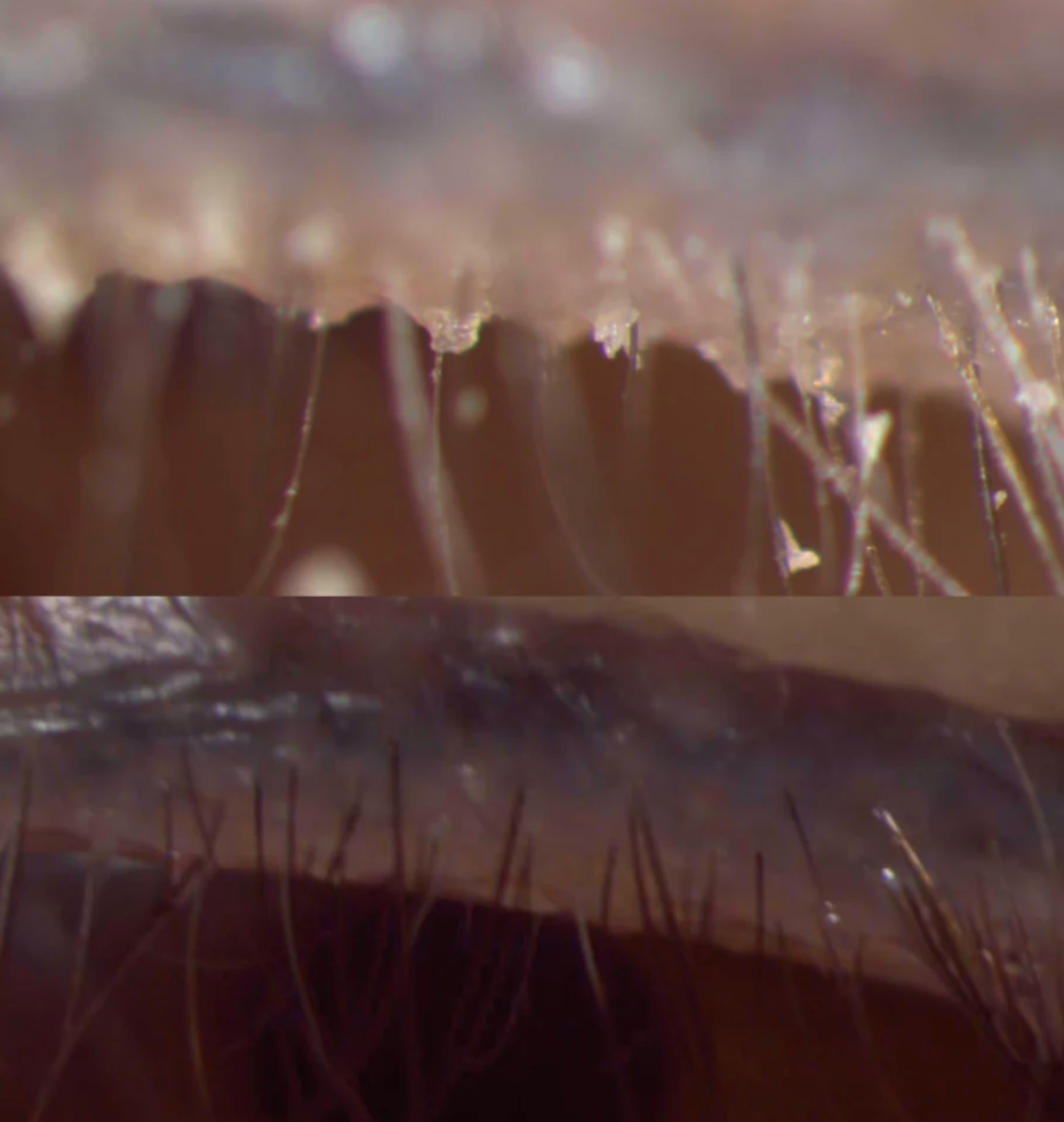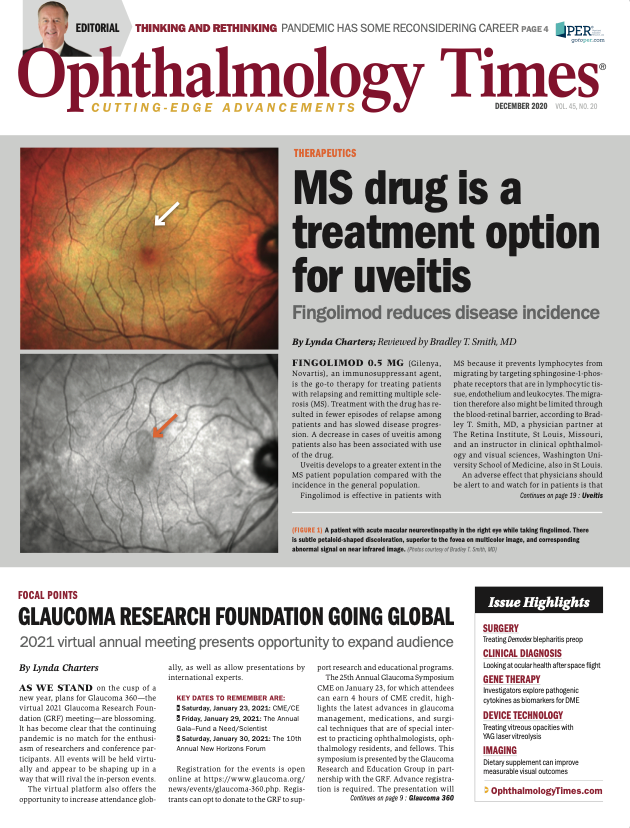Publication
Article
Digital Edition
Treating Demodex blepharitis efficiently before surgery
Author(s):
New options open possibilities for treatment, resulting in better outcomes for patients.
Before and after treatment with in-office microblepharoexfoliation. Patient maintained the improvements with a variety of home maintenance strategies. (Photos courtesy of Laura M. Periman, MD)


Special to Ophthalmology Times®
Any time we perform ocular surgery—whether cataract, refractive, glaucoma, oculoplastic, or any other ocular procedure—we want to set the patient up for success.
Part of that is addressing any potential sources of infection, inflammation, and ocular surface disease that could complicate the postoperative course. It is common to see patients with meibomian gland dysfunction (MGD), dry eye disease (DED), and blepharitis.
For long-term efficacy, therapeutic choices are focused on the underlying cause or causes of the problem.
Related: Considering Demodex infestation and cataract surgery
Demodex was 1 potential cause that we tended to overlook or ignore, because there was little we could do to address the specific problem of Demodex mite infestation.
Now we are beginning to understand the role of Demodex in blepharitis and inflammatory DED, and the treatment outlook has markedly improved.
Diagnosing Demodex blepharitis
The signature sign of Demodex is the presence of collarettes, or cylindrical dandruff, at the base of the eyelashes.1
These waxy collarettes are the waste material of Demodex mites living inside the hair follicles. When you regularly look for collarettes, you’ll likely be surprised at how common Demodex blepharitis is in your patients.
About 84% of people 60 years or older have Demodex infestation, as do 100% of patients 70 years or older.2
Younger patients have Demodex overpopulation as well, particularly those with MGD and keratitis.3
The higher incidence in older populations is not well understood. We hypothesize that the natural defenses and skin barrier function may be compromised with age, allowing Demodex to gain the upper hand, but we do not know for certain.
Related: Drop shows effectiveness for Demodex blepharitis in phase 2a study
Patients with Demodex can have a spectrum of manifestations, from asymptomatic infestation to significant blepharitis inflammation.
Generally, significant Demodex infestation results in significant inflammation. Patients have classic dry eye and blepharitis symptoms, including dry or gritty feeling, foreign body sensation and fluctuating vision.
Because mites inside the lash follicles cause the condition, patients also can have follicular distention, hyperplasia, eyelash loss, and eyelid keratinization.2 Demodex blepharitis and bacterial blepharitis are also strongly correlated.3
In-office and at-home treatments
Despite its prevalence, there have been few treatments for Demodex infestation, and there are no treatments approved for that specific indication.
Although many patients with Demodex infestation come to me having already been prescribed an immunomodulator such as cyclosporine (Cequa; Sun Pharma; Restasis; Allergan) or lifitegrast (Xiidra; Novartis), these medications treat the ocular surface sequelae of Demodex infestation rather than the infestation itself.
Related: Making dry eye manageable for patients working from home
We could hypothesize that these medications might increase the ability to fight Demodex by reducing inflammation and improving skin health, but we do not have evidence to support that idea.
Certain comorbidities, such as diabetes, place patients at higher risk for Demodex blepharitis, so a primary care physician should help manage any systemic condition that has not been adequately controlled.
To prepare a patient with Demodex infestation for surgery, I usually use a combination of mechanical and chemical methods to remove collarettes, kill mites, and enhance skin barrier function in the patient.
Home maintenance
For patients, home maintenance is important to help keep the Demodex population under control. It is key to communicate this to patients.
In the office, we can perform microblepharoexfoliation using mechanical tools (AB Max; Myco Industries; BlephEx) or kits that combine tools and agents to treat Demodex (Cliradex; Bio-Tissue; ZEST; Zocular).
Related: Where to start with treating OSD patients
Because there is an association between Demodex and rosacea, intense pulsed light (IPL) therapy (Optima IPL; Lumenis) can be used to decrease the Demodex burden in patients also afflicted with rosacea.4
In severe cases of Demodex, ivermectin can be prescribed orally or topically (Soolantra; Galderma) to control the facial Demodex burden.
Hygiene is key
At home, good hygiene is essential to keep Demodex under control after in-office treatment, but traditional shampoos are not very effective.
Cleansing towelettes with 4-terpineol isolate (Cliradex; Bio-Tissue), the miticidal component of tea tree oil, have the highest antidemodectic activity of all the commercial cleansers.5
Related: The role of IPL in OSD treatment
Patients use the towelettes to clean the eyelids, lashes, and face. Hypochlorous acid cleanser (Avenova; NovaBay Pharmaceuticals), which I use for many dry eye patients, has minimal effect on Demodex,6 but it can be used as a complementary therapy to 4-terpineol isolate.
Patients can also use a device at home that cleans the eyelid margins and stimulates the meibomian glands (NuLids; NuSight Medical), as well as gel cleaner for the eyelids and lashes (ZocuShield; Zocular).
A growing list of options
Many of the options I use to treat Demodex blepharitis are very new, and more treatments are in development. They are the consequence of our growing understanding of the disease and the pressing need to address it effectively.
We have gone from strictly mechancal approaches to removing the mites, to chemical options, to the possibility of pharmaceutical options for the treatment of patients with this issue.
Related: Amid pandemic, friendly bugs can help protect the eye from infection
Our ability to efficiently address the Demodex burden that is driving blepharitis and inflammation is growing rapidly, making it easier than ever to resolve the problem before elective surgery and keep patients on track long term.
About the author
Laura M. Periman, MD
e:dryeyemaster@gmail.com
Periman is an ocular surface disease expert and director, dry eye services and clinical research, Periman Eye Institute, Seattle, Washington.
---
References
1. Gao YY, Di Pascuale MA, Li W, et al. High prevalence of Demodex in eyelashes with cylindrical dandruff. Invest Ophthalmol Vis Sci. 2005;46(9):3089-3094. doi:10.1167/iovs.05-0275
2. Liu J, Sheha H, Tseng SCG. Pathogenic role of Demodex mites in blepharitis. Curr Opin Allergy Clin Immunol. 2010;10(5):505-510. doi:10.1097/ACI.0b013e32833df9f4
3. Liang L, Liu Y, Ding X, Ke H, Chen C, Tseng SCG. Significant correlation between meibomian gland dysfunction and keratitis in young patients with Demodex brevis infestation. Br J Ophthalmol. 2018;102(8):1098-1102. doi:10.1136/bjophthalmol-2017-310302
4. Fishman HA, Periman LM, Shah AA. Real-time video microscopy of In vitro Demodex death by intense pulsed light. Photobiomodul Photomed Laser Surg. 2020;38(8):472-476. doi:10.1089/photob.2019.4737
5. Cheung IMY, Xue AL, Kim A, Ammundsen K, Wang MTM, Craig JP. In vitro anti–demodectic effects and terpinen-4-ol content of commercial eyelid cleansers. Cont Lens Anterior Eye. 2018;41(6):513-517. doi:10.1016/j.clae.2018.08.003
6. Kabat AG. In vitro demodicidal activity of commercial lid hygiene products. Clin Ophthalmol. 2019;13:1493-1497. doi:10.2147/OPTH.S209067

Newsletter
Don’t miss out—get Ophthalmology Times updates on the latest clinical advancements and expert interviews, straight to your inbox.




